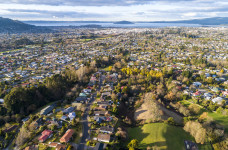Government launches long-term vision for housing and urban development
Published 29 Sept 21
The Government has laid out its long-term vision for housing and urban development in Aotearoa New Zealand, ensuring we have the infrastructure and homes needed to nurture thriving communities in the decades to come.
The Government Policy Statement on Housing and Urban Development (GPS-HUD provides certainty to all those working within the system that Government policies and investments are aligned to tackle the acute challenges of the housing crisis today and deliver a shared, consistent, and enduring set of outcomes in the long term.
To ensure we can deliver the best housing and urban outcomes for whānau Māori, the Government has also released MAIHI Ka Ora the National Māori Housing Strategy (MAIHI Ka Ora). These long-term plans have been developed in parallel and they are strongly connected through Te Maihi o te Whare Māori – the Māori Housing Innovation (MAIHI) Framework for Action.
This connection ensures that when we set the vision for housing and urban development to guide future work, we created space for Māori to determine their own path they would take to tackle housing challenges using a ‘by Māori, for Māori’ approach.
GPS-HUD
The GPS-HUD takes a multi-decade outlook with outcomes for people, communities, the New Zealand economy, and our built and natural environments at its centre.
It will inform and influence the actions of agencies involved in housing and urban development and sets expectations for how Kāinga Ora - Homes and Communities (Kāinga Ora) manages its functions and operations. It is intended to shape future policy, investment, and programmes of work.
The vision set out in the GPS-HUD is that everyone in Aotearoa New Zealand lives in a home and within a community that meets their needs and aspirations.
This vision is supported by a set of outcomes that will help to keep us on track, a set of key focus areas and priorities that outline the actions we need to take over the short to medium term, and how government will work within the system to transform housing and urban outcomes.
The GPS-HUD includes a set of initial indicators to help measure progress and the health of the housing and urban system.
While the focus areas and priorities of future governments might change, including responses to a changing environment and new knowledge, our aspiration is that the long-term vision and outcomes in the GPS-HUD will remain constant and relevant.
You can read the full document on the GPS-HUD page.
MAIHI Ka Ora
Maihi Ka Ora, the National Māori Housing strategy, has a shared vision that “All whānau have safe, healthy, affordable homes with secure tenure, across the Māori housing continuum.”
It takes Te Maihi o te Whare Māori – Māori and Iwi Housing Innovation Framework for Action (MAIHI) which drives a whole of system approach and elevates it to provide the strategic direction for the whole Māori housing system.
Over a number of decades, through many and various iterations, Governments have acknowledged and tried to address the housing challenges facing Māori, iwi, hapū and whānau.
The Waitangi Tribunal’s Wai 2750 Kaupapa inquiry into Māori Housing Policy and Services has outlined the impact of years of insufficient responses to Māori housing issues that have had an intergenerational impact on Māori communities, impacts that continue to be felt today.
The lack of new housing supply, the poor quality of existing Māori housing and the unaffordability for Māori to rent or own their own home is not a new problem, but it is a problem that has been exacerbated by a worsening housing crisis and the impacts of COVID 19.
To effectively address the long-standing challenges in Māori housing, we need to respond, review and reset the system. We cannot continue to expect different housing outcomes for Māori from a system that has failed to put Māori at its centre for too long.
That is why this strategy looks to do things differently.
Maihi Ka Ora is not just a government strategy for Māori housing. This is a strategy that has been co-designed with Māori in the housing sector. Its implementation demands both Māori and the Crown work together in genuine partnership. It takes the MAIHI Framework for Action which drives a whole of system approach and elevates it to provide the strategic direction for the whole Māori housing system.
Over the next 30 years, our Māori Crown partnership will look to make changes that will improve the housing outcomes for future generations of Māori, their whānau and their mokopuna.
The new strategy aims to take a complex issue, and a fragmented system – and simplify it. It breaks down the problems, puts in place actions that will help solve the problems, and actions and timeframes to ensure we get the work done and shift the system to achieve our shared outcomes and improve whānau well-being.
We do not work in isolation from the wider housing effort being undertaken by the Government, Māori and iwi and hapū groups. We have developed the strategy alongside the Government Policy Statement on Housing and Urban Development to ensure they are both cohesive and consistent in their approaches, actions and aspirations for a better housing system.
This will ensure that it is not just the Māori Housing strategy that delivers for Māori – but that the entire system is better positioned to deliver equity and equality across the housing continuum that places whānau at its centre.
To ensure that our strategy adequately addresses the immediate and short term challenges facing Māori housing we need to address key priority areas.
The total Māori housing problem can be broken into six major components.
They are:
- Māori Crown Partnerships
- Māori-led Local Solutions
- Māori Housing Supply
- Māori Housing Support
- Māori Housing System
- Māori Housing Sustainability
Under each priority area we looked to identify areas and work streams where we need to Respond, Review or Reset to ensure we can achieve the ultimate goals for the future of Māori Housing.
This forms the basis of the full implementation programmes that will be designed in partnership with Māori and completed by the end of the year.
Visit our MAIHI Ka Ora page for more information.



